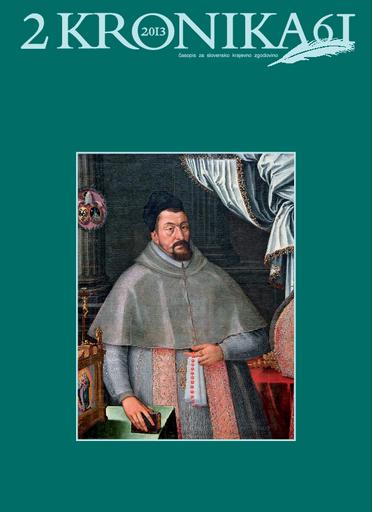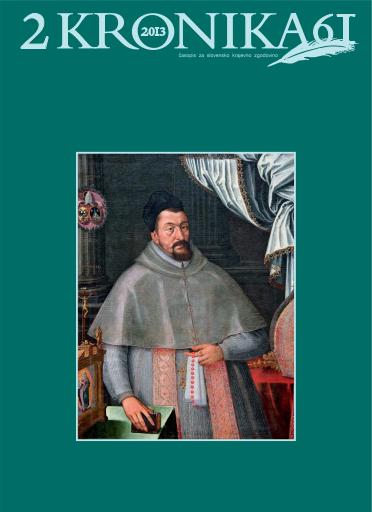/
Serijske publikacije
/
Kronika: časopis za slovensko krajevno zgodovino
Popotovanje od Pariza do Ljubljane v obdobju Ilirskih provinc

Avtor(ji):Irena Žmuc
Soavtor(ji):Miha Preinfalk (odg. ur.), Barbara Šterbenc Svetina (teh. ur.), Manca Gašperšič (prev.), Luka Vidmar (prev.), Mina Černe (prev.), Irena Žmuc (prev.), Mojca Bensa (prev.), Vinko Oblak (prev.)
Leto:2013
Založnik(i):Zveza zgodovinskih društev Slovenije, Ljubljana
Vir(i):Kronika, 2013, št. 2
Jezik(i):slovenščina
Vrst(e) gradiva:besedilo
Ključne besede:Potopis Pariz–Ljubljana, 1811, Ilirske province (1809–1813), ceste, poštne postaje, Paris–Ljubljana itinerary, 1811, Illyrian Provinces (1809–1813), roads, coaching inns
Avtorske pravice:

To delo avtorja Irena Žmuc je ponujeno pod Creative Commons Priznanje avtorstva-Nekomercialno-Brez predelav 4.0 Mednarodna
Datoteke (1)

Ime:kronika-2013_2.pdf
Velikost:27.44MB
Format:application/pdf
Stalna povezava:https://hdl.handle.net/11686/file18348
Opis
Potovanje Pariz–Ljubljana je v začetku 19. stoletja sestavljalo pet glavnih cestnih odsekov v Francoskem
cesarstvu: odsek št. 8 Pariz–Dijon, odsek št. 44 Dijon–Dôle, odsek št. 70 Dôle–Ženeva in odsek št. 137 Ženeva–
Milano. Zadnji odsek št. 107 je bila relacija Milano–Videm–Gorica–Postojna s ciljem v Ljubljani. Potnik se je iz
glavnega mesta francoskega cesarstva Pariza do prestolnice Ilirskih provinc Ljubljane ustavil na 151 ¼ poštnih
postajah, prevozil je 302 ¼ lig (francoskih milj). Pot je opisana v Itinéraire complet de l'empire français.
Second édition, considérablement augmentée, comprenant la Hollande, une partie de l'Allemagne, l'Italie,
et les Provinces Illyriennes. Itinéraire je ponujal poleg transportnih informacij tudi gospodarske in kulturnozgodovinske
orise krajev, skozi katere je vodila pot. Gospodarski interes je Francoze vodil na vzhod, zato so
vzdrževali in popravljali ceste ter vodne poti.
Metapodatki (12)
- identifikatorhttps://hdl.handle.net/11686/34982
- naslov
- Popotovanje od Pariza do Ljubljane v obdobju Ilirskih provinc
- Travelling from Paris to Ljubljana at the time of the Illyrian provinces
- ustvarjalec
- Irena Žmuc
- soavtor
- Miha Preinfalk (odg. ur.)
- Barbara Šterbenc Svetina (teh. ur.)
- Manca Gašperšič (prev.)
- Luka Vidmar (prev.)
- Mina Černe (prev.)
- Irena Žmuc (prev.)
- Mojca Bensa (prev.)
- Vinko Oblak (prev.)
- predmet
- Potopis Pariz–Ljubljana
- 1811
- Ilirske province (1809–1813)
- ceste
- poštne postaje
- Paris–Ljubljana itinerary
- 1811
- Illyrian Provinces (1809–1813)
- roads
- coaching inns
- opis
- Potovanje Pariz–Ljubljana je v začetku 19. stoletja sestavljalo pet glavnih cestnih odsekov v Francoskem cesarstvu: odsek št. 8 Pariz–Dijon, odsek št. 44 Dijon–Dôle, odsek št. 70 Dôle–Ženeva in odsek št. 137 Ženeva– Milano. Zadnji odsek št. 107 je bila relacija Milano–Videm–Gorica–Postojna s ciljem v Ljubljani. Potnik se je iz glavnega mesta francoskega cesarstva Pariza do prestolnice Ilirskih provinc Ljubljane ustavil na 151 ¼ poštnih postajah, prevozil je 302 ¼ lig (francoskih milj). Pot je opisana v Itinéraire complet de l'empire français. Second édition, considérablement augmentée, comprenant la Hollande, une partie de l'Allemagne, l'Italie, et les Provinces Illyriennes. Itinéraire je ponujal poleg transportnih informacij tudi gospodarske in kulturnozgodovinske orise krajev, skozi katere je vodila pot. Gospodarski interes je Francoze vodil na vzhod, zato so vzdrževali in popravljali ceste ter vodne poti.
- The route from Paris to Ljubljana in the early 19th century consisted of five main road sections in the French Empire: section no. 8 Paris–Dijon, section no. 44 Dijon–Dôle, section no. 70 Dôle–Geneva and section no. 137 Geneva–Milan. The fifth section, section no. 107, covered the route Milan–Udine–Gorizia–Postojna with the final destination in Ljubljana. A person travelling from Paris, the capital of the French Empire, to Ljubljana, the capital of the Illyrian Provinces, stopped at 151 ¼ coaching inns, covering up to 302 ¼ leagues (French miles). The route is described in Itinéraire complet de l'empire français. Second édition, considérablement augmentée, comprenant la Hollande, une partie de l'Allemagne, l'Italie, et les Provinces Illyriennes. Along with transport information, the Itinéraire also contained economic and cultural-historical descriptions of the places along the route. Pursuing economic interests in the east, the French maintained and repaired both roads and waterways.
- Apart from controlling both land routes and, after introducing the Continental Blockade, the Adriatic Sea, the French considered the Illyrian Provinces (1809–1813) as a springboard for their trading with the Levant. Mainly so as to secure their economic interests, they promptly established a postal service connecting Paris with Ljubljana, the capital town of the »napoli on«* state. A description of the Paris–Ljubljana route features in the Itinéraire complet de l'empire français. Second édition, considérablement augmentée, comprenant la Hollande, une partie de l'Allemagne, l'Italie, et les Provinces Illyriennes (Paris, M.DCCCXI), route N. 107, pp. 337–357. The Bibliothéque nationale de France provided photocopies of the Itinerary relating to the last section of the route from Treviso to Ljubljana, pp. 337, 354–357 and the cover page. The distance from Paris, the capital of the French Empire, to Ljubljana comprised 302 ¼ leagues or something between 1,296 and 1,345.6 kilometres. To promote trade, the French maintained the road network in the Balkans and established a postal service, with Ljubljana being a crossing of 1st class significant routes leading to the east, i.e. to Dubrovnik, and to the north, i.e. to Vienna. The said towns and crossings were easy to follow on an Austrian military special map from the early 20th century. It was noticed, however, that the distances between towns were somewhat imprecise (although the former route alignments do not correspond to the present ones). The most deviating was the distance of 5 leagues between Vrhnika and Idrija, which would mean only slightly more than 22 kilometres. Ljubljana is described as a hustling centre of interest to a traveller: of significance was the town’s exciting everyday life, including the sights such as the river, the cathedral, the church of St. Peter, the town hall, two parks, a canal, the castle on the hill, the Auersperg Palace together with a renowned library and the cabinet of curiosities as well as a couple of schools. Given the strong economic interests, most of the attention, and enthusiasm, is paid to the mercury mine in Idrija. The length of the journey can be assessed: if a mail coach drove at a speed of 10 kilometres per hour (as regulated in the Habsburg Monarchy) and was on its way for 10 hours per day (some of this time was used for stops and rehitching horses), the Paris–Ljubljana distance was covered in approximately 13 days. The express postal service took eight days for the same distance. The Governor- General thus received ‘his’ daily post from Paris by relay, with the 'news' being already eight days old!
- založnik
- Zveza zgodovinskih društev Slovenije
- datum
- 2013
- tip
- besedilo
- jezik
- Slovenščina
- jeDelOd
- pravice
- licenca: ccByNcNd
